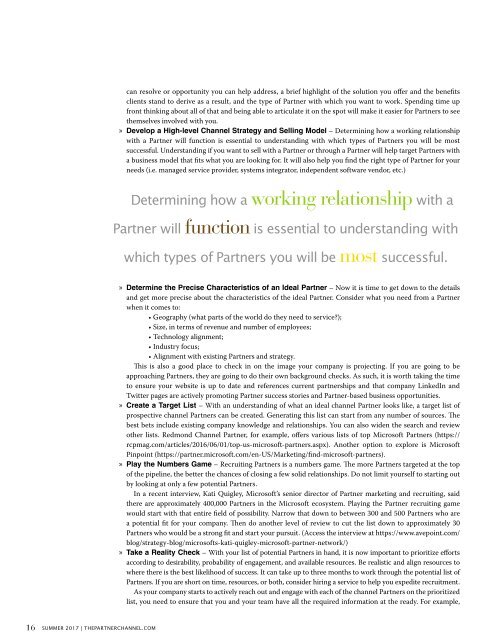The Partner Channel Magazine Summer 2017
Finding the perfect fit isn't always easy. Whether you're looking for shoes or a Partner to take your business to the next level. This quarter's magazine covers SMART Partnerships, marketing best practices, and more.
Finding the perfect fit isn't always easy. Whether you're looking for shoes or a Partner to take your business to the next level. This quarter's magazine covers SMART Partnerships, marketing best practices, and more.
You also want an ePaper? Increase the reach of your titles
YUMPU automatically turns print PDFs into web optimized ePapers that Google loves.
can resolve or opportunity you can help address, a brief highlight of the solution you offer and the benefits<br />
clients stand to derive as a result, and the type of <strong>Partner</strong> with which you want to work. Spending time up<br />
front thinking about all of that and being able to articulate it on the spot will make it easier for <strong>Partner</strong>s to see<br />
themselves involved with you.<br />
»»<br />
Develop a High-level <strong>Channel</strong> Strategy and Selling Model – Determining how a working relationship<br />
with a <strong>Partner</strong> will function is essential to understanding with which types of <strong>Partner</strong>s you will be most<br />
successful. Understanding if you want to sell with a <strong>Partner</strong> or through a <strong>Partner</strong> will help target <strong>Partner</strong>s with<br />
a business model that fits what you are looking for. It will also help you find the right type of <strong>Partner</strong> for your<br />
needs (i.e. managed service provider, systems integrator, independent software vendor, etc.)<br />
Determining how a working relationship with a<br />
<strong>Partner</strong> will function is essential to understanding with<br />
which types of <strong>Partner</strong>s you will be most successful.<br />
»»<br />
Determine the Precise Characteristics of an Ideal <strong>Partner</strong> – Now it is time to get down to the details<br />
and get more precise about the characteristics of the ideal <strong>Partner</strong>. Consider what you need from a <strong>Partner</strong><br />
when it comes to:<br />
• Geography (what parts of the world do they need to service?);<br />
• Size, in terms of revenue and number of employees;<br />
• Technology alignment;<br />
• Industry focus;<br />
• Alignment with existing <strong>Partner</strong>s and strategy.<br />
This is also a good place to check in on the image your company is projecting. If you are going to be<br />
approaching <strong>Partner</strong>s, they are going to do their own background checks. As such, it is worth taking the time<br />
to ensure your website is up to date and references current partnerships and that company LinkedIn and<br />
Twitter pages are actively promoting <strong>Partner</strong> success stories and <strong>Partner</strong>-based business opportunities.<br />
»»<br />
Create a Target List – With an understanding of what an ideal channel <strong>Partner</strong> looks like, a target list of<br />
prospective channel <strong>Partner</strong>s can be created. Generating this list can start from any number of sources. <strong>The</strong><br />
best bets include existing company knowledge and relationships. You can also widen the search and review<br />
other lists. Redmond <strong>Channel</strong> <strong>Partner</strong>, for example, offers various lists of top Microsoft <strong>Partner</strong>s (https://<br />
rcpmag.com/articles/2016/06/01/top-us-microsoft-partners.aspx). Another option to explore is Microsoft<br />
Pinpoint (https://partner.microsoft.com/en-US/Marketing/find-microsoft-partners).<br />
»»<br />
Play the Numbers Game – Recruiting <strong>Partner</strong>s is a numbers game. <strong>The</strong> more <strong>Partner</strong>s targeted at the top<br />
of the pipeline, the better the chances of closing a few solid relationships. Do not limit yourself to starting out<br />
by looking at only a few potential <strong>Partner</strong>s.<br />
In a recent interview, Kati Quigley, Microsoft’s senior director of <strong>Partner</strong> marketing and recruiting, said<br />
there are approximately 400,000 <strong>Partner</strong>s in the Microsoft ecosystem. Playing the <strong>Partner</strong> recruiting game<br />
would start with that entire field of possibility. Narrow that down to between 300 and 500 <strong>Partner</strong>s who are<br />
a potential fit for your company. <strong>The</strong>n do another level of review to cut the list down to approximately 30<br />
<strong>Partner</strong>s who would be a strong fit and start your pursuit. (Access the interview at https://www.avepoint.com/<br />
blog/strategy-blog/microsofts-kati-quigley-microsoft-partner-network/)<br />
»»<br />
Take a Reality Check – With your list of potential <strong>Partner</strong>s in hand, it is now important to prioritize efforts<br />
according to desirability, probability of engagement, and available resources. Be realistic and align resources to<br />
where there is the best likelihood of success. It can take up to three months to work through the potential list of<br />
<strong>Partner</strong>s. If you are short on time, resources, or both, consider hiring a service to help you expedite recruitment.<br />
As your company starts to actively reach out and engage with each of the channel <strong>Partner</strong>s on the prioritized<br />
list, you need to ensure that you and your team have all the required information at the ready. For example,<br />
16 SUMMER <strong>2017</strong> | THEPARTNERCHANNEL.COM














